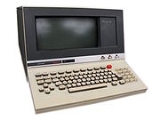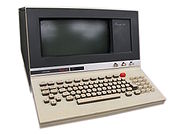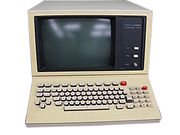
Uniscope
Encyclopedia


Teletype Corporation
The Teletype Corporation, a part of American Telephone and Telegraph Company's Western Electric manufacturing arm since 1930, came into being in 1928 when the Morkrum-Kleinschmidt Company changed its name to the name of its trademark equipment...
. Due to the text color on the original models, these terminals are informally known as green screen terminals. Unlike Teletype
Teletype Corporation
The Teletype Corporation, a part of American Telephone and Telegraph Company's Western Electric manufacturing arm since 1930, came into being in 1928 when the Morkrum-Kleinschmidt Company changed its name to the name of its trademark equipment...
terminals, the Uniscope minimizes the number of I/O interrupts required by accepting large blocks of data, and uses a high speed proprietary communications interface, using coax cable and hardware devices known as multiplexors. A Uniscope operator awaits a prompt from the remote mainframe. The prompt indicates that the mainframe is ready to receive input. The operator enters data, offline from the mainframe, and then presses the Transmit button. The terminal locks the keyboard and sends to the mainframe what the operator entered. All the data goes in a single transmission and that causes a single interrupt at the mainframe. Eventually, the mainframe responds, sometimes with a single line; other times with a screen-load of data. And the cycle repeats.
Uniscope was a registered trade mark for a set of Sperry Univac dumb terminal products. The trademark was applied for October 13, 1969. Several models were produced: the Uniscope 300, Uniscope 100, Uniscope 200, the UTS 400, the UTS 10, the UTS 20, the UTS 30, the UTS 40 and the color UTS 60. The UTS 10, UTS 20, UTS 30, UTS 40 and the color UTS 60 were "intelligent terminals" powered by 8-bit microprocessors, predecessor of today's powerful chips that run today's PCs. There was also the UTS 4000 cluster controller and terminal line, and the SVT-1120. Various models supported 16x64, 12x80, and 24x80 display formats. The UTS 4000 line had a COBOL compiler available that made it possible to do local processing in the cluster controller, and the UTS 60 was also capable of being programmed. This line of terminals roughly paralleled the similar IBM product, the IBM 3270
IBM 3270
The IBM 3270 is a class of block oriented terminals made by IBM since 1972 normally used to communicate with IBM mainframes. As such, it was the successor to the IBM 2260 display terminal. Due to the text colour on the original models, these terminals are informally known as green screen terminals...
. The UTS-400-TE was specialized terminal that had a powerful text editing program burned into firmware intended at first to allow for the editing of simple copy such as that for a newspaper, and later adapted as a prototype word processor with 8" floppy disks and driving Letter Quality daisy wheel printers.
A proprietary communications protocol
Communications protocol
A communications protocol is a system of digital message formats and rules for exchanging those messages in or between computing systems and in telecommunications...
was common to all members of the Uniscope product line. Groups of terminals were generally dropped off a common communications line via a multiplexer (mux) and identified by remote identifier and station identifier symbols. Some terminal
Computer terminal
A computer terminal is an electronic or electromechanical hardware device that is used for entering data into, and displaying data from, a computer or a computing system...
s may have been equipped with peripheral devices such as printers
Computer printer
In computing, a printer is a peripheral which produces a text or graphics of documents stored in electronic form, usually on physical print media such as paper or transparencies. Many printers are primarily used as local peripherals, and are attached by a printer cable or, in most new printers, a...
and recording devices (cartridge tape or floppy disk) which were identified on the communications line by a device identifier. Terminals on a drop were sequentially polled
Polling (computer science)
Polling, or polled operation, in computer science, refers to actively sampling the status of an external device by a client program as a synchronous activity. Polling is most often used in terms of input/output , and is also referred to as polled or software driven .Polling is sometimes used...
for traffic, sometimes with a general poll to which any terminal with traffic could respond. A fairly complex data presentation protocol permitted application programmers to format a screen for any number of business purposes. For example, fields could be described that would accept only numeric or alpha-numeric characters. Some fields could not be changed by the terminal operator. A protocol extension permitted programmers to specify color for each field and lines on the borders of each cell (underline, or vertical bars, etc.) The Uniscope display protocol, while proprietary, roughly parallel the ANSI X3.64 standard.
The color UTS 60 terminal using two Motorola processors arrived on the market at about the same time as desktop computers with EGA monitors. The general consensus was that the UTS60 was over-engineered and overpriced for the emerging market. Eventually emulation software for the Uniscope line running on desktop computers ended manufacturing of the genuine article. Screen size of the original Uniscope 100 was 12 X 80 or 16 x 64 characters. All letters were in capital. Each character was individually drawn as a series of splines using technology developed for displays in military cockpits. Later Uniscopes supported a 24 X 80 screen using raster technology, and upper and lower case characters. There were versions that had the various national code sets for different European countries to enable pound signs, and various accented characters, etc. There were also versions that had Katakana code sets for Japanese.
Unisys developed the INFOConnect terminal emulators for PCs that included use of the Uniscope protocols in the early 1990s. There continue to be vendors that sell terminal emulators for these machines.

